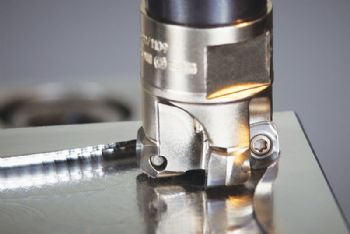
Tooling company Seco Tools (UK) Ltd, Alcester , describes high-feed milling as a roughing method designed to help manufacturers achieve higher metal removal rates, reduce cycle times and optimise productivity (
www.secotools.com).
Seco says that, in essence, the process involves using shallow depths of cut — plus tools with large cutting radii and/or small lead angles — to ensure that the cutting forces created during the machining process are directed back towards the machine spindle in an axial direction.
This ensures increased tool and machining stability, which in turn allows higher feed rates to be used — up to 10-times the normal rate.
Seco says that even though high-feed milling is generally described as a ‘roughing strategy’, it is possible with the right cutting tools for manufacturers to create ‘near net’ shapes in fewer passes and move from roughing to fine finishing — negating the need for semi-finishing operations.
Moreover, the company says the process can be applied to a wide range of materials and offers particular advantages when cutting those that are regarded as ‘difficult to machine’.
High-feed milling is used increasingly in the aerospace, medical and mould tool and die sectors.
Seco says: “High-feed milling is a generic ‘catch-all’ description that includes a range of specific milling operations, including face milling, copy milling, pocketing, helical inter-polation, slotting, copying and plunging.
The process itself is particularly beneficial when machining deep pockets with long tool overhangs, because using a shallow depth of cut results in low radial cutting forces and virtually zero vibration, thereby ensuring high levels of process stability, increased tool life and improved productivity.”
Seco’s high-feed milling tools are always being refined, and two new ranges of cutters have recently been added. JHF181 provides a high-feed geometry and was developed for machining hardened steels, super-alloys and titanium; it is available in diameters ranging from 2 to 16mm and is particularly suitable for machining small workpieces and cavities.
Meanwhile, HF6 ‘shell end mills’ have double-sided six-edged negative inserts and are designed for machining P and K materials.
Mike Fleming, Seco’s sales and marketing manager, says: “By working with Seco, manufacturers can incorporate and integrate high-feed milling into their operations, and by doing so achieve process times that are 3- to 10-times faster than when using conventional methods.”